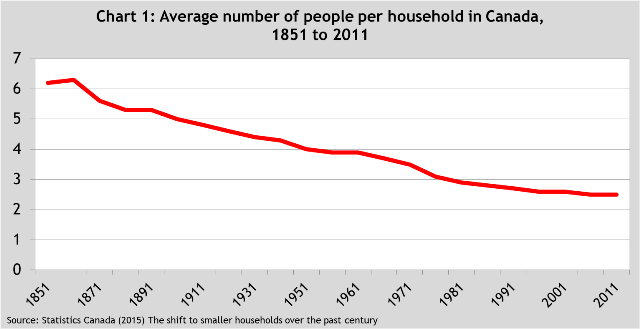Smaller households matter when we measure income inequality
Recently released data from Statistics Canada highlights a fundamental shift in Canadian society over the past century and a half. Indeed, Canadians are having fewer children and are more likely to live alone, which means the average number of people per household has been steadily declining. This fact has wide reaching implications, not least of which is how it informs the debate about income inequality in Canada.
In 1851, the average household, consisting of relatives and non-relatives living in the same dwelling, was much larger than is the case today (see Chart 1 below). Back then, the average household had 6.2 members. By 1976, the average household had fallen by half to 3.1 members. The average size continued to fall, reaching 2.5 household members in 2011. Put differently, the average household in 1851 was about two and half times larger than in 2011.

A smaller average household means that the household’s income will be spread among fewer people. For instance, parents with fewer children have fewer mouths to feed and fewer backs to clothe. Consider two households with the same income but where one has six members and the other has three. The potential resources available to each member of the smaller household would be larger. While the larger household can share some costs such as furniture and housing in ways that reduce the per-person costs, its total costs are still higher than the smaller household. Thus, a straight comparison of the income level of differently sized households does not portray an accurate picture of the inequality between households.
Inequality is a complex issue with many key nuances that are generally considered in academic research but often lost in the popular debate. The reality of declining average household size is one of them, particularly since measures of income inequality are generally based on household, not individual, data. Failing to account for the dramatic change in household size over time will contribute to a misleading depiction of income inequality in society. After all, both the level and growth in inequality is less pronounced after adjusting for household size.
This was demonstrated in a recent study led by Nipissing University professor Chris Sarlo that compared different measures of income inequality. The study found that the share of after-tax income earned by the top 20 per cent of economic families (which excludes singles) was smaller and grew more modestly from 1982 to 2010 after adjusting for household size (see Chart 2 below). Specifically, the unadjusted share of income grew by 11.2 per cent, while the adjusted share grew by only 6.5 per cent. Similar results were found for other measures of inequality.

Income inequality is a hotly debated issue with potentially important policy implications, so it is critical to have a clear picture of the true extent and change in inequality. Among other things, this requires accounting for the fact that the average Canadian household has shrunk in size over time.
Authors:
Subscribe to the Fraser Institute
Get the latest news from the Fraser Institute on the latest research studies, news and events.

